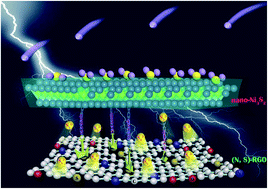Ni3S2 anchored to N/S co-doped reduced graphene oxide with highly pleated structure as a sulfur host for lithium–sulfur batteries†
Abstract
Reported herein is the investigation of a unique cathode candidate for Li–S batteries, i.e. Ni3S2/(N, S)-RGO-type hybrid materials, which are expected to optimize battery performance by elevating the utilization of sulfur and chemically confining the adsorption/diffusion of polysulfide. Versatile structural and compositional characterizations confirmed the uniform growth and strong chemical coupling of nanostructured Ni3S2 on the N/S co-doped RGO matrix. Rich physical and chemical properties were revealed, namely, the large specific surface area and pore volume, which are beneficial for polysulfide capture, and the 3D conductive network supporting rapid charge transfer to the Ni3S2-polysulfide interface to improve the intrinsic equilibrium of the polysulfide. Specifically, the integration of ∼28.2 wt% of Ni3S2 produced a highly pleated composite with the largest BET specific surface area (618 m2 g−1) and pore volume (1.73 cm3 g−1) among the hybrids studied. This typical material also performed the best in the battery test, recording ultra-high cycling stability over 1000 cycles at the current density of 3C with the capacity decay of 0.023% per cycle. As the sulfur loading per unit area became as dense as 5.8 mg cm−2, the specific capacities were measured as 6.72 mA h cm−2 (at 0.05C), while the capacity retention for the 200-cycle test (at 1C) was still preserved above 72.5%.



 Please wait while we load your content...
Please wait while we load your content...